Study on the Interaction between Wheel Polygon and Rail Corrugation in High-Speed Railways
Abstract
:1. Introduction
2. Simulation Model and Theoretical Method
2.1. Finite Element Model of Wheel–Rail Contact
2.2. Theoretical Models of Wheel Polygonization and Rail Corrugation
2.3. Theoretical Method of Friction Coupling Vibration Analysis
3. Comparative Study of Different Wheel–Rail Contact Conditions
4. Parametric Analyses
4.1. Wheel–Rail Friction Coefficient
4.2. Depth of Periodic Wear
5. Conclusions
Author Contributions
Funding
Institutional Review Board Statement
Informed Consent Statement
Data Availability Statement
Acknowledgments
Conflicts of Interest
References
- Ma, C.Z.; Gao, L.; Xin, T.; Cai, X.; Nadakatti, M.M.; Wang, P. The dynamic resonance under multiple flexible wheelset-rail interactions and its influence on rail corrugation for high-speed railway. J. Sound Vib. 2021, 498, 115968. [Google Scholar] [CrossRef]
- Furuya, A.; Madanat, S. Accounting for Network Effects in Railway Asset Management. J. Transp. Eng. 2013, 139, 92–100. [Google Scholar] [CrossRef]
- Zhao, X.N.; Chen, G.X.; Lv, J.Z.; Zhang, S.; Wu, B.W.; Zhu, Q. Study on the mechanism for the wheel polygonal wear of high-speed trains in terms of the frictional self-excited vibration theory. Wear 2019, 426–427, 1820–1827. [Google Scholar] [CrossRef]
- Wu, Y.; Du, X.; Zhang, H.J.; Wen, Z.F.; Jin, X.S. Experimental analysis of the mechanism of high-order polygonal wear of wheels of a high-speed train. J. Zhejiang Univ. Sci. A 2017, 18, 579–592. [Google Scholar] [CrossRef]
- Wei, L.; Zong, L.X.; Luo, S.H.; He, X.M. Research into the problem of wear creating a polygon-shaped wheel on metro trains. Proc. Inst. Mech. Eng. Part F J. Rail Rapid Transit 2014, 230, 43–55. [Google Scholar] [CrossRef] [Green Version]
- MORYS, B. Enlargement of out-of-round wheel profiles on high-speed trains. J. Sound Vib. 1999, 227, 965–978. [Google Scholar] [CrossRef]
- Fröhling, R.; Spangenberg, U.; Reitmann, E. Root cause analysis of locomotive wheel tread polygonisation. Wear 2019, 432–433, 102911. [Google Scholar] [CrossRef]
- Tao, G.Q.; Wen, Z.F.; Liang, X.R.; Ren, D.X.; Jin, X.S. An investigation into the mechanism of the out-of-round wheels of metro train and its mitigation measures. Veh. Syst. Dyn. 2018, 57, 1–16. [Google Scholar] [CrossRef]
- Cai, W.B.; Chi, M.R.; Wu, X.W.; Li, F.; Wen, Z.F.; Liang, S.L.; Jin, X.S. Experimental and numerical analysis of the polygonal wear of high-speed trains. Wear 2019, 440–441, 203079. [Google Scholar] [CrossRef]
- Correa, N.; Oyarzabal, O.; Vadillo, E.G.; Santamaria, J.; Gomez, J. Rail corrugation development in high-speed lines. Wear 2011, 271, 2438–2447. [Google Scholar] [CrossRef]
- Bao, P.Y.; Cui, X.L.; Ding, H.H.; Yin, Y.; Du, Z.X.; Yang, Z.C. Influences of friction self-excited vibration characteristics of various types of high-speed trains on rail corrugations in braking sections. Eng. Fail. Anal. 2022, 134, 106087. [Google Scholar] [CrossRef]
- Yu, M.; Wang, W.D.; Liu, J.Z.; Sun, S.C. The transient response of high-speed wheel/rail rolling contact on “roaring rails” corrugation. Proc. Inst. Mech. Eng. Part F J. Rail Rapid Transit 2019, 233, 1068–1080. [Google Scholar] [CrossRef]
- Braghin, F.; Lewis, R.; Dwyer-Joyce, R.S.; Bruni, S. A mathematical model to predict railway wheel profile evolution due to wear. Wear 2006, 261, 1253–1264. [Google Scholar] [CrossRef]
- Sun, Y.; Guo, Y.; Zhai, W.M. Prediction of rail non-uniform wear—Influence of track random irregularity. Wear 2019, 420–421, 235–244. [Google Scholar] [CrossRef]
- Zhao, X.; Wen, Z.F.; Wang, H.Y.; Jin, X.S.; Zhu, M.H. Modeling of high-speed wheel-rail rolling contact on a corrugated rail and corrugation development. J. Zhejiang Univ. Sci. A 2014, 15, 946–963. [Google Scholar] [CrossRef] [Green Version]
- Nielsen, J.C.O.; Johansson, A. Out-of-round railway wheels-a literature survey. Proc. Inst. Mech. Eng. Part F J. Rail Rapid Transit 2005, 214, 79–91. [Google Scholar] [CrossRef]
- Knothe, K.; Grassie, S.L. Workshop on rail corrugations and out-of-round wheels. J. Sound Vib. 1999, 227, 895–897. [Google Scholar]
- Lu, C.X.; Shi, J. Dynamic response of vehicle and track in long downhill section of high-speed railway under braking condition. Adv. Struct. Eng. 2019, 23, 523–537. [Google Scholar] [CrossRef]
- Zhu, Q.; Chen, G.X.; Kang, X.; Ren, W.J. Effect of Wheel Structure on Friction-Induced Wheel Polygonal Wear of High-Speed Train. Tribol. Trans. 2021, 64, 606–615. [Google Scholar] [CrossRef]
- Meehan, P.A.; Batten, R.D.; Bellette, P.A. The effect of non-uniform train speed distribution on rail corrugation growth in curves/corners. Wear 2016, 366–367, 27–37. [Google Scholar] [CrossRef] [Green Version]
- Wu, B.W.; Qiao, Q.F.; Chen, G.X.; Lv, J.Z.; Zhu, Q.; Zhao, X.N.; Ouyang, H. Effect of the unstable vibration of the disc brake system of high-speed trains on wheel polygonaliation. Proc. Inst. Mech. Eng. Part F J. Rail Rapid Transit 2019, 234, 80–95. [Google Scholar] [CrossRef]
- Zhong, S.Q.; Xiao, X.B.; Wen, Z.F.; Jin, X.S. The Effect of First-Order Bending Resonance of Wheelset at High Speed on Wheel-Rail Contact Behavior. Adv. Mech. Eng. 2013, 2013, 296106. [Google Scholar] [CrossRef]
- Dong, Y.H.; Cao, S.Q. Generation and Evolution Conditions of Polygonal Wear of High-Speed Wheel. Shock Vib. 2021, 2021, 6793351. [Google Scholar] [CrossRef]
- Zhai, W.M.; Jin, X.S.; Wen, Z.F.; Zhao, X. Wear Problems of High-Speed Wheel/Rail Systems: Observations, Causes, and Countermeasures in China. Appl. Mech. Rev. 2020, 72, 060801. [Google Scholar] [CrossRef]
- Kang, X.; Chen, G.X.; Song, Q.F.; Dong, B.J.; Zhang, Y.X.; Dai, H.Y. Effect of wheelset eccentricity on the out-of-round wheel of high-speed trains. Eng. Fail. Anal. 2022, 131, 105816. [Google Scholar] [CrossRef]
- Li, J.B.; Shi, H.M. Rail Corrugation Detection of High-Speed Railway Using Wheel Dynamic Responses. Shock Vib. 2019, 2019, 2695647. [Google Scholar] [CrossRef] [Green Version]
- Cui, X.L.; Chen, G.X.; Ouyang, H.J. Study on the Effect of Track Curve Radius on Friction-Induced Oscillation of a Wheelset–Track System. Tribol. Trans. 2019, 62, 688–700. [Google Scholar] [CrossRef]
- El Beshbichi, O.; Wan, C.; Bruni, S.; Kassa, E. Complex eigenvalue analysis and parameters analysis to investigate the formation of railhead corrugation in sharp curves. Wear 2020, 450–451, 203150. [Google Scholar] [CrossRef]
- Cui, X.L.; Chen, G.X.; Zhao, J.W.; Yan, W.Y.; Ouyang, H.J.; Zhu, M.H. Field investigation and numerical study of the rail corrugation caused by frictional self-excited vibration. Wear 2017, 376–377, 1919–1929. [Google Scholar] [CrossRef]
- Zhao, X.N.; Chen, G.X.; Huang, Z.Y.; Xia, C.G. Study on the Different Effects of Power and Trailer Wheelsets on Wheel Polygonal Wear. Shock Vib. 2020, 2020, 2587152. [Google Scholar] [CrossRef]
- Chen, M.; Sun, Y.; Guo, Y.; Zhai, W.M. Study on effect of wheel polygonal wear on high-speed vehicle-track-subgrade vertical interactions. Wear 2019, 432–433, 102914. [Google Scholar] [CrossRef]
- Wu, Y.; Han, J.; Zuo, Q.Y.; Jin, X.S.; Xiao, X.B.; Liang, S.L. Effect of rail corrugation on initiation and development of polygonal wear on high-speed train wheels. J. Mech. Eng. 2020, 56, 198–208. [Google Scholar]
- Faccoli, M.; Petrogalli, C.; Lancini, M.; Ghidini, A.; Mazzù, A. Effect of desert sand on wear and rolling contact fatigue behaviour of various railway wheel steels. Wear 2018, 396–397, 146–161. [Google Scholar] [CrossRef]
- Donzella, G.; Faccoli, M.; Ghidini, A.; Mazzù, A.; Roberti, R. The competitive role of wear and RCF in a rail steel. Eng. Fract. Mech. 2005, 72, 287–308. [Google Scholar] [CrossRef]
- Zhang, S.Y.; Spiryagin, M.; Lin, Q.; Ding, H.H.; Wu, Q.; Guo, J.; Liu, Q.Y.; Wang, W.J. Study on wear and rolling contact fatigue behaviours of defective rail under different slip ratio and contact stress conditions. Tribol. Int. 2022, 169, 107491. [Google Scholar] [CrossRef]




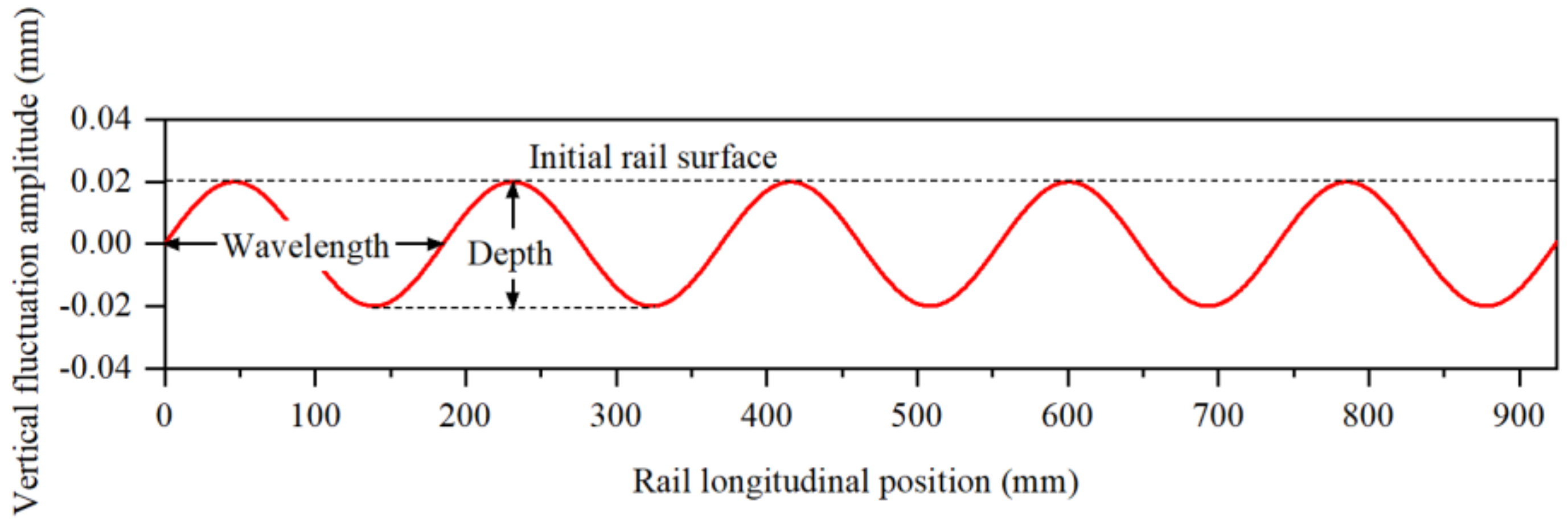
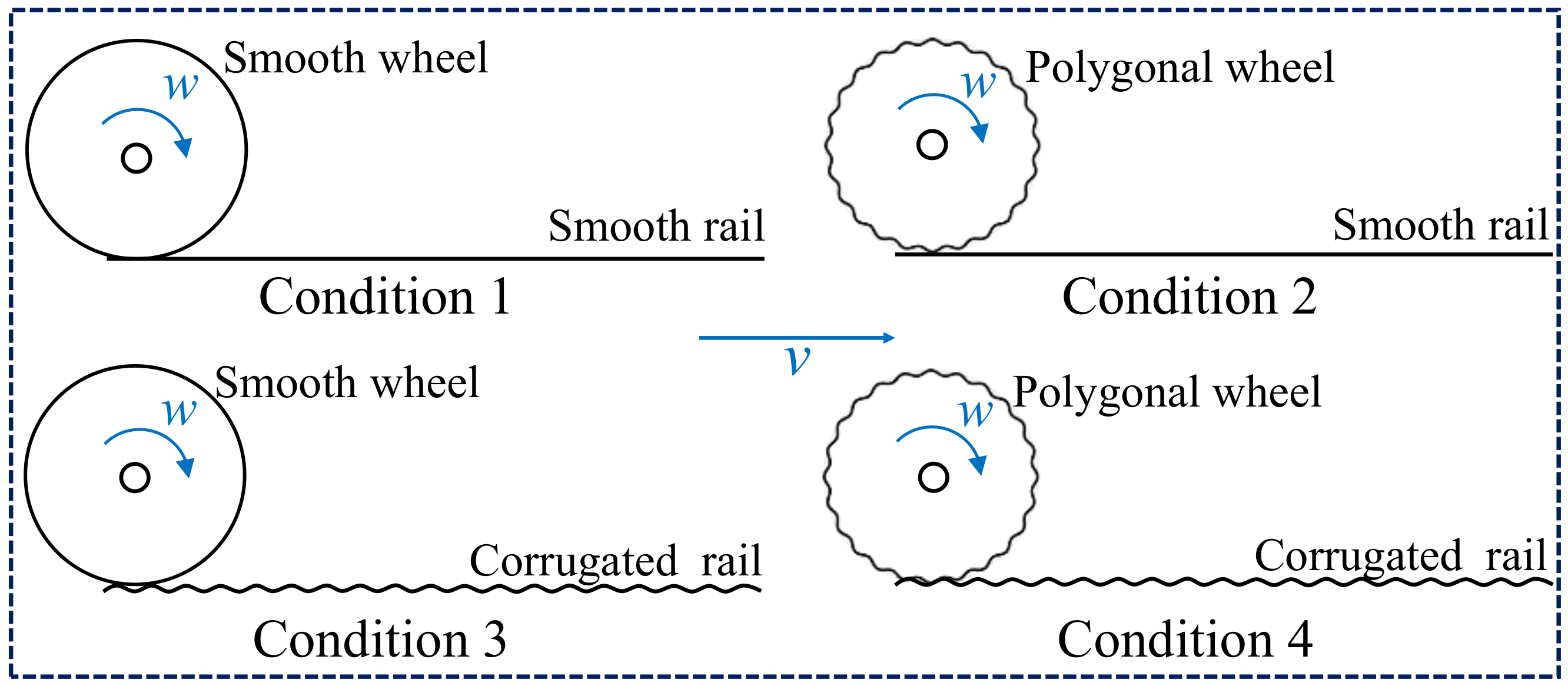
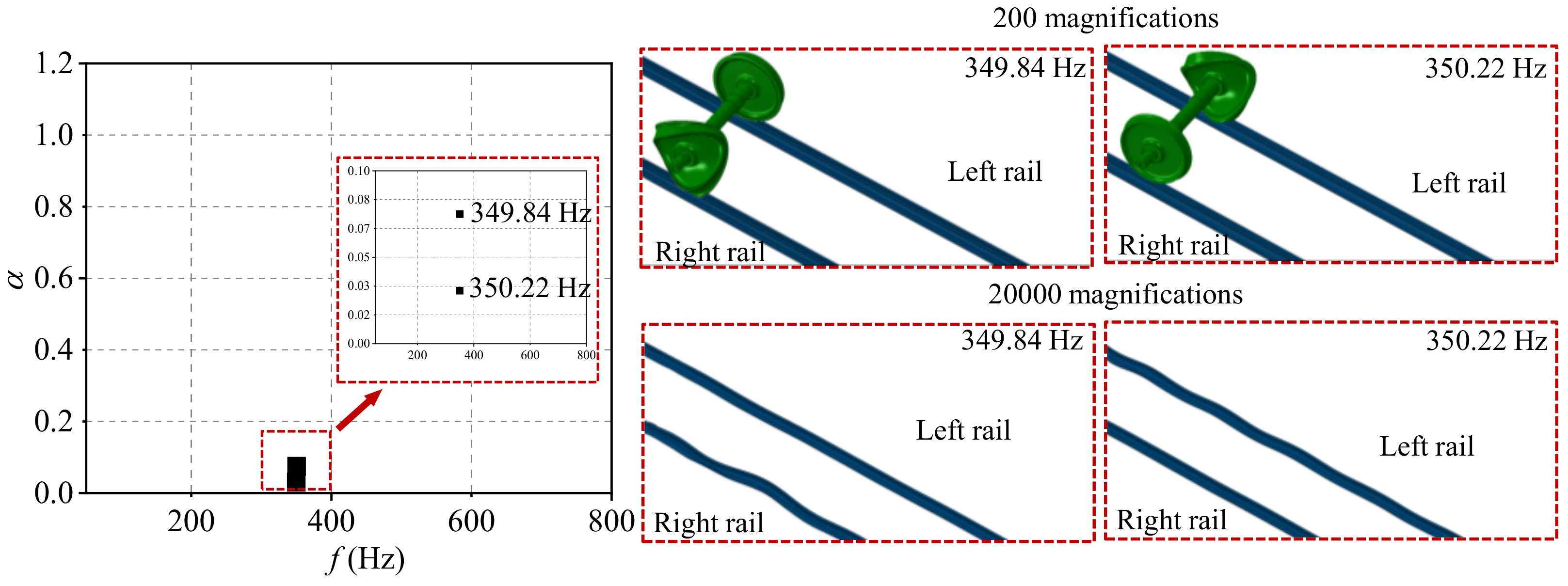


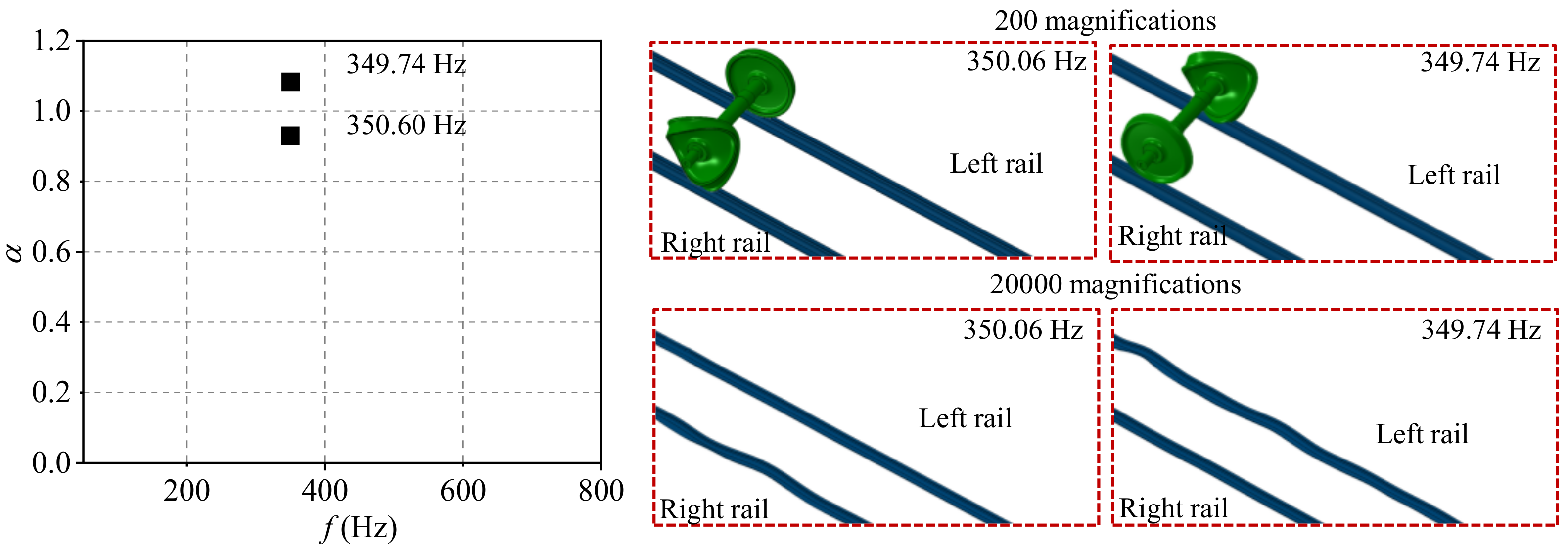
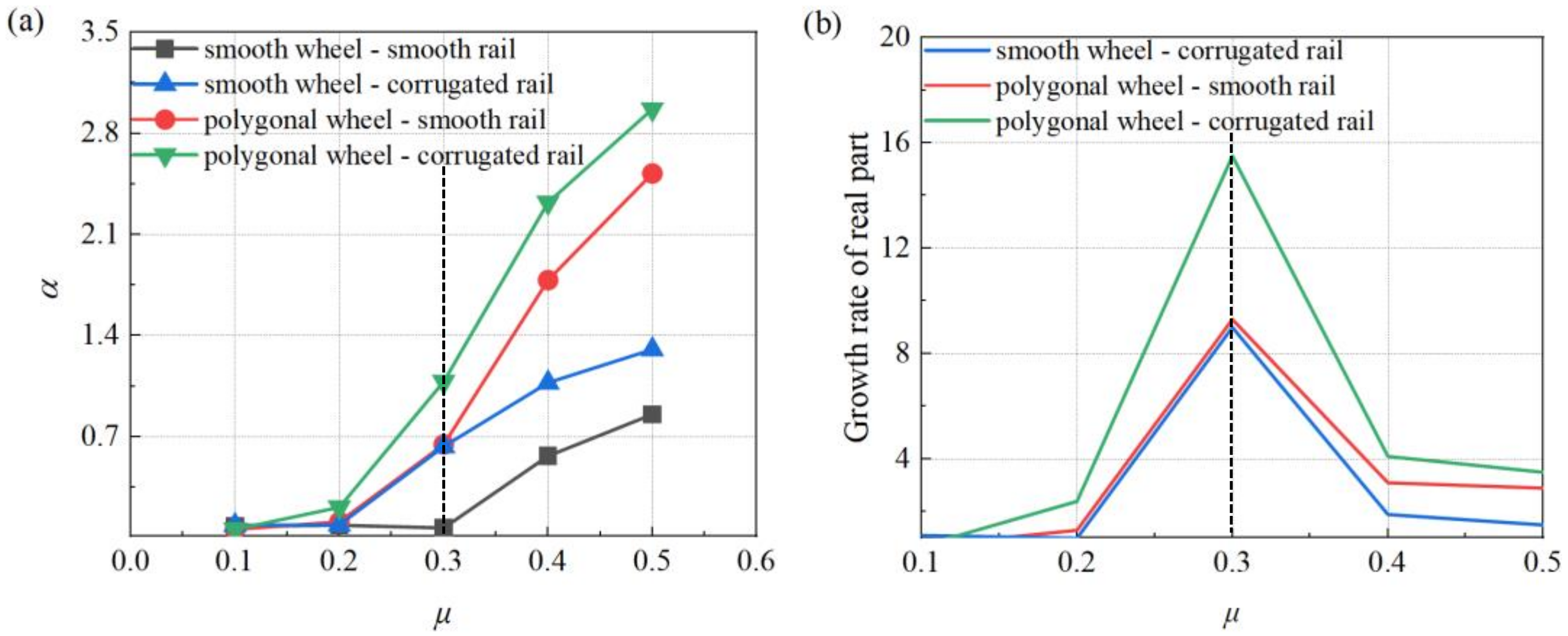

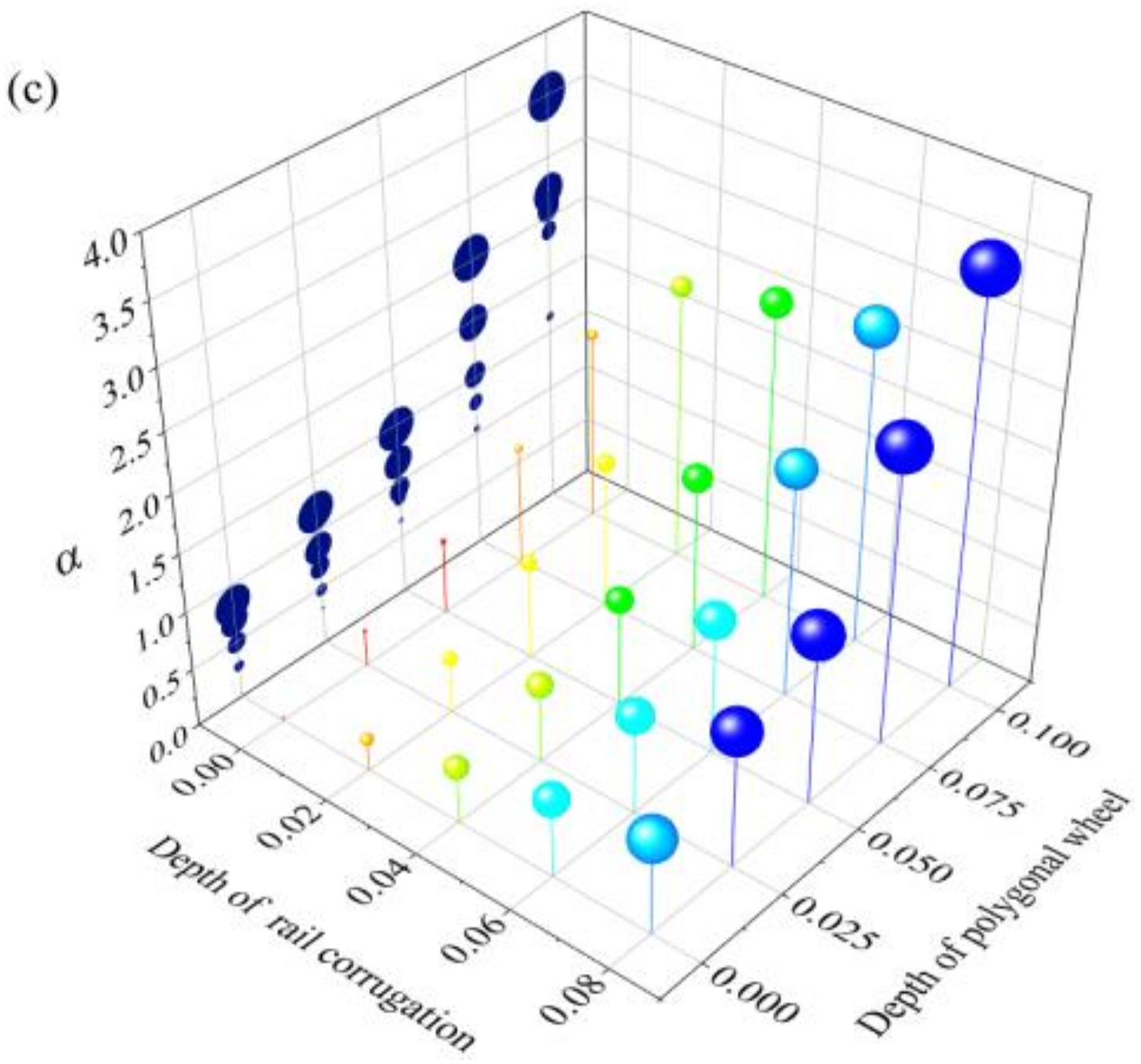
| Condition | System | Real Part | Frequency | Location |
|---|---|---|---|---|
| 1 | smooth wheel–smooth rail | 0.0307 | 349.84 Hz | Left |
| 0.0749 | 350.22 Hz | Right | ||
| 2 | polygonal wheel–smooth rail | 0.6619 | 349.83 Hz | Left |
| 0.6487 | 349.72 Hz | Right | ||
| 3 | smooth wheel–corrugated rail | 0.4892 | 349.92 Hz | Left |
| 0.6343 | 349.70 Hz | Right | ||
| 4 | polygonal wheel–corrugated rail | 0.9303 | 350.06 Hz | Left |
| 1.0833 | 349.74 Hz | Right |
Publisher’s Note: MDPI stays neutral with regard to jurisdictional claims in published maps and institutional affiliations. |
© 2022 by the authors. Licensee MDPI, Basel, Switzerland. This article is an open access article distributed under the terms and conditions of the Creative Commons Attribution (CC BY) license (https://creativecommons.org/licenses/by/4.0/).
Share and Cite
Xu, X.; Cui, X.; Xu, J.; Wen, X.; Yang, Z. Study on the Interaction between Wheel Polygon and Rail Corrugation in High-Speed Railways. Materials 2022, 15, 8765. https://doi.org/10.3390/ma15248765
Xu X, Cui X, Xu J, Wen X, Yang Z. Study on the Interaction between Wheel Polygon and Rail Corrugation in High-Speed Railways. Materials. 2022; 15(24):8765. https://doi.org/10.3390/ma15248765
Chicago/Turabian StyleXu, Xiaotian, Xiaolu Cui, Jia Xu, Xiaoxia Wen, and Zongchao Yang. 2022. "Study on the Interaction between Wheel Polygon and Rail Corrugation in High-Speed Railways" Materials 15, no. 24: 8765. https://doi.org/10.3390/ma15248765






